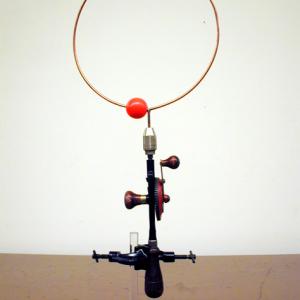College of Liberal Arts & Sciences
1D50.57 - Central Forces - Ball on Hoop
Video Credit: Jonathan M. Sullivan-Wood.
Attach the apparatus to a short table rod with a parallel rod clamp. Slowly rotate the apparatus until the ball swings upward. As you slow the rotation rate, the ball will smoothly move down towards the starting point. The ball will never go over the "equator".
NOTE: To get the ball to move initially from its starting point will require a rotation rate greater than 1.6 revolutions per second and then the ball will jump up to fairly high level. That is why it is usually better to start your explanation when the ball is at its highest level and then slow the rotation rate gradually until the ball is back at the rest point.
- N. Gauthier, "Rotational Motion on a Hoop", TPT, Vol. 33, #5, May 1995, p. 262.
- Said Shakerin, "Apparatus for Rotational Motion", TPT, Vol. 33, #3, Mar. 1995, p. 173.
- Thomas E. Baker and Andreas Bill, "Jacobi Elliptic Functions and the Complete Solution to the Bead on the Hoop Problem", AJP, Vol. 80, #6, June 2012, p. 506.
- Richard V. Mancuso and Guy A. Schreiber, "An Improved Apparatus for Demonstrating First- and Second-Order Phase Transitions: Ball Bearings on a Rotating Hoop", AJP, Vol. 73, #4, Apr. 2005, p. 366.
- Richard V. Mancuso, "A Working Mechanical Model for First- and Second-Order Phase Transitions and the Cusp Catastrophe", AJP, Vol. 68, #3, Mar. 2000, p. 271.
- Richard J. Fitzgerald, "Observing New Geometric Phases in the Lab", Physics Today, Vol. 71, #10, Oct. 2018, p. 21.
Disclaimer: These demonstrations are provided only for illustrative use by persons affiliated with The University of Iowa and only under the direction of a trained instructor or physicist. The University of Iowa is not responsible for demonstrations performed by those using their own equipment or who choose to use this reference material for their own purpose. The demonstrations included here are within the public domain and can be found in materials contained in libraries, bookstores, and through electronic sources. Performing all or any portion of any of these demonstrations, with or without revisions not depicted here entails inherent risks. These risks include, without limitation, bodily injury (and possibly death), including risks to health that may be temporary or permanent and that may exacerbate a pre-existing medical condition; and property loss or damage. Anyone performing any part of these demonstrations, even with revisions, knowingly and voluntarily assumes all risks associated with them.
